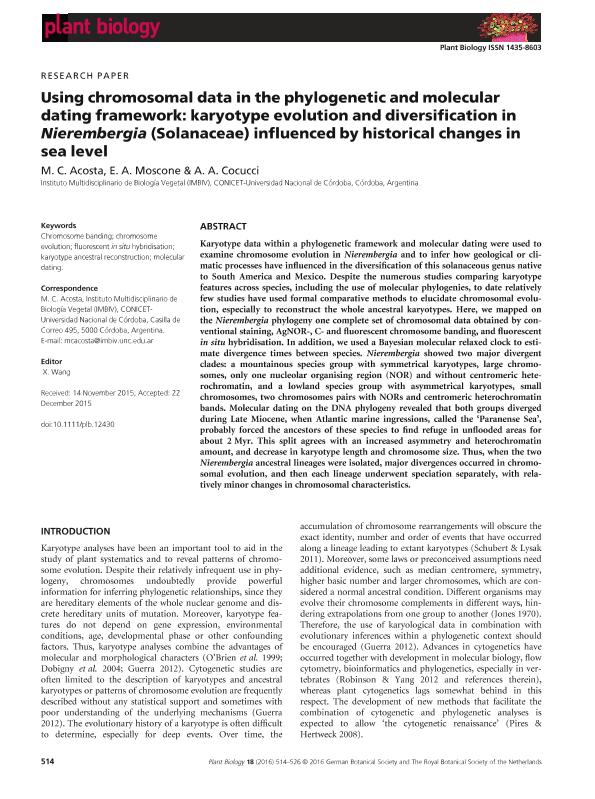Artículo
Using chromosomal data in the phylogenetic and molecular dating framework: Karyotype evolution and diversification in Nierembergia (Solanaceae) influenced by historical changes in sea level
Fecha de publicación:
03/2016
Editorial:
Wiley Blackwell Publishing, Inc
Revista:
Plant Biology
ISSN:
1435-8603
e-ISSN:
1438-8677
Idioma:
Inglés
Tipo de recurso:
Artículo publicado
Clasificación temática:
Resumen
Karyotype data within a phylogenetic framework and molecular dating were used to examine chromosome evolution in Nierembergia and to infer how geological or climatic processes have influenced in the diversification of this solanaceous genus native to South America and Mexico. Despite the numerous studies comparing karyotype features across species, including the use of molecular phylogenies, to date relatively few studies have used formal comparative methods to elucidate chromosomal evolution, especially to reconstruct the whole ancestral karyotypes. Here, we mapped on the Nierembergia phylogeny one complete set of chromosomal data obtained by conventional staining, AgNOR-, C- and fluorescent chromosome banding, and fluorescent in situ hybridisation. In addition, we used a Bayesian molecular relaxed clock to estimate divergence times between species. Nierembergia showed two major divergent clades: a mountainous species group with symmetrical karyotypes, large chromosomes, only one nucleolar organising region (NOR) and without centromeric heterochromatin, and a lowland species group with asymmetrical karyotypes, small chromosomes, two chromosomes pairs with NORs and centromeric heterochromatin bands. Molecular dating on the DNA phylogeny revealed that both groups diverged during Late Miocene, when Atlantic marine ingressions, called the 'Paranense Sea', probably forced the ancestors of these species to find refuge in unflooded areas for about 2 Myr. This split agrees with an increased asymmetry and heterochromatin amount, and decrease in karyotype length and chromosome size. Thus, when the two Nierembergia ancestral lineages were isolated, major divergences occurred in chromosomal evolution, and then each lineage underwent speciation separately, with relatively minor changes in chromosomal characteristics.
Archivos asociados
Licencia
Identificadores
Colecciones
Articulos(IMBIV)
Articulos de INST.MULTIDISCIPL.DE BIOLOGIA VEGETAL (P)
Articulos de INST.MULTIDISCIPL.DE BIOLOGIA VEGETAL (P)
Citación
Acosta, María Cristina; Moscone, Eduardo Alberto; Cocucci, Andrea Aristides; Using chromosomal data in the phylogenetic and molecular dating framework: Karyotype evolution and diversification in Nierembergia (Solanaceae) influenced by historical changes in sea level; Wiley Blackwell Publishing, Inc; Plant Biology; 18; 3; 3-2016; 514-526
Compartir
Altmétricas




